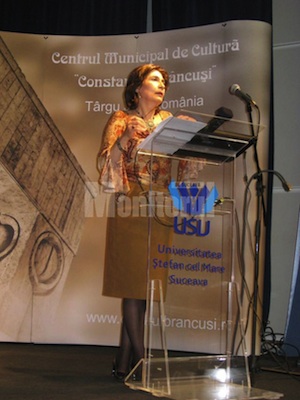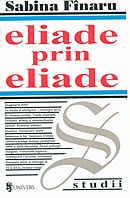

Associate Professor in the Department of Romanian Language and Literature of the Faculty of Letters, “Stefan cel Mare” University of Suceava, Romania, Sabina Fînaru graduated from the Faculty of Philology (Romanian and Latin) and completed her Ph.D. with a thesis on Mircea Eliade.
Since 1992 at the University of Suceava she has taught the History of Romanian Literature (the Beginnings and Romanticism), a course on Mircea Eliade, and Latin. Between 2000 and 2002 she taught the Romanian language and held conferences on Romanian literature and civilization at Delhi University (India).
She is a member of the Association of Bukovinian writers (Suceava), of the Society for Classical Studies (the Iasi subsidiary) and of the Indo-Romanian Cultural Association (India). She is a founding member of the Inter Litteras Research Center, “Stefan cel Mare” University, Suceava and of the Suceava subsidiary of the “Stefan Lupascu” Foundation of Culture and Science.
She has been given the prize of the Association of Bukovinian Writers for literary history and criticism (2004) and the award of the Cultural Foundation of Bukovina for the restitution of classical culture (2005).
Eliade prin Eliade (III-rd edition, Bucharest, 2006), Literatura română de la început (Suceava, 2005), Curs de limba latină cu elemente de literatură, cultură şi civilizaţie (Suceava, 2004).

Our consideration of the Eliadian archetype deliberately dissociates us from Ioan-Petru Culianu and Adrian Marino’s definition of it as performative and transcendent, aprioristic and morphologic, and as realized according to the description of religious phenomena by way of a binary opposition of the historical and the ahistorical. Instead we consider the sacred archetype in Eliade not only as an archetype of origin but also as a transcendental “chronotope,” manifesting a bi-unitary, mobile, self-generative and reversible character. The Eliadian archetype is repeatable in the absolute, and it re-innovates ontological meaning. We represent the dynamics of this renovatio (the preservation and expansion characteristic of the sacred archetype) by analogy with an endless column, as in Brancuşi (which evokes Blaga’s mioritic space vertically transposed). We elucidate Eliade's view of the sacred by recourse to his procosmic, philosophical anthropology of the religious type, whose model is the Romanian sacramental view of existence as embodied in “cosmic” Christianity, which enables man to recover “origin” so as to transgress and even oppose history without controverting it. The artist, the hermeneutical critic, the initiated theologian, even the academic specialist in “the sacred” can help man cultivate this native capacity of his.
(See Eliade prin Eliade, ediţia a III-a, Editura Univers, Bucureşti)